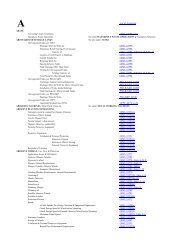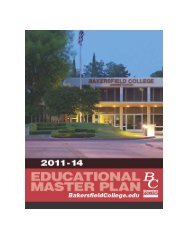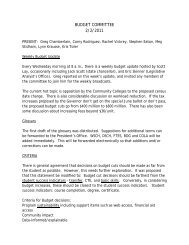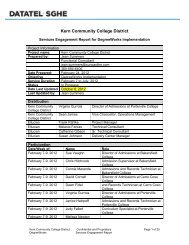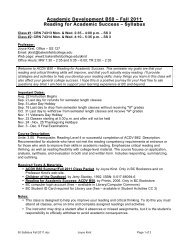Addendum with evidence (8.2 MB) - Accreditation - Bakersfield ...
Addendum with evidence (8.2 MB) - Accreditation - Bakersfield ...
Addendum with evidence (8.2 MB) - Accreditation - Bakersfield ...
You also want an ePaper? Increase the reach of your titles
YUMPU automatically turns print PDFs into web optimized ePapers that Google loves.
• State budget deficits will translate to a continued reduction in funding for services <strong>with</strong>in<br />
Kern County, including those of education. At the same time, there will be an even greater<br />
demand for educational services. To address this demand <strong>Bakersfield</strong> College may need to<br />
place a greater emphasis on not-for-credit and contract education classes that pay for<br />
themselves.<br />
• Non-government jobs <strong>with</strong>in the county that will experience the greatest stability and growth<br />
will be in Professional Services, Healthcare, Logistics, Agribusiness and Wholesale and<br />
Retail Trade.<br />
• The College can expect local government (county and cities) to continue <strong>with</strong> their struggles,<br />
balancing the need for services <strong>with</strong> reduced revenues. The financial burden will result in<br />
reduction of services and capital expenditures. Some of these reductions may impact the<br />
College, particularly in the area of shared infrastructure upgrades.<br />
Conditions for Higher Education<br />
Several key policy decisions will influence the California Community College system in the<br />
coming years. The College is part of the national and State higher education community. As such, it<br />
has a public responsibility to make decisions in light of national goals, policies and resources.<br />
Speaking at Macomb Community College (Michigan) in July 2009, President Obama articulated the<br />
American Graduation Initiative (AGI), which has a goal of increasing the percentage of U.S.<br />
residents who earn high quality degrees and credentials from the present rate of 39 percent to a rate<br />
of 60 percent by the year 2025. The Lumina Foundation and the Bill and Melinda Gates Foundation<br />
have developed similar goals for increasing the educated population. Both philanthropic<br />
organizations are preparing to provide incentives, which are intended to stimulate students to<br />
complete degree programs successfully. While it has been announced that some new federal<br />
resources will be allocated for use by community colleges, the Congress is currently also struggling<br />
to restrain spending and to reduce debt levels. This may have an impact on the amount of money<br />
that the community colleges receive.<br />
President Obama has pushed to increase college graduation rates across the nation.<br />
Complete College America, a non-profit organization, was formed to advance this mission. It has<br />
enlisted support from 22 state leaders to ensure greater numbers of students to acquire degrees. In its<br />
publication, Time is the Enemy, has focused national attention on several key observations:<br />
• Nontraditional students are the new majority<br />
• Part-time students rarely graduate<br />
• Graduation rates are especially low for students who are of African American or Hispanic<br />
descent; as well as students who are older or poorer than the typical student<br />
• Students are wasting time earning excess credits, and taking too much time to earn a degree<br />
• Too many students need remediation, and too few succeed when they get it 2<br />
The Gates, Ford, Lumina, and Kellogg Foundations as well as the Carnegie Corporation of<br />
New York fund their work and the efforts of others to promote change in higher education.<br />
2 Complete College America. Time Is The Enemy. September 2011<br />
21



